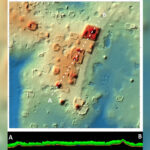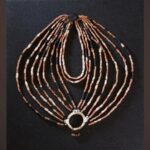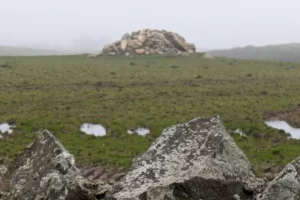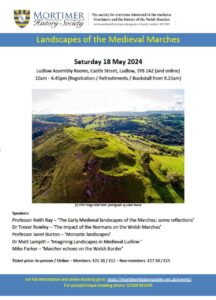Glass fragments from earliest glass workshop north of the Alps – see below for details
Missing ‘body’ of ice age animal carving finally found — but nobody knows what the animal is:
Date: 7 Aug 2023 Source: livescience.com
 Summary: Archaeologists in Germany have unearthed the missing segment of an ice age ivory carving in the Hohle Fels cave, a UNESCO World Heritage Site. Initially believed to represent a horse, the newly discovered “body” of the carving has led to uncertainty, with experts debating whether it depicts a cave lion or a cave bear. The 35,000-year-old figurine’s head was previously found in the same cave. The carving’s features resemble both a bear and a cave lion, making its exact representation ambiguous. The artifact, crafted by the Aurignacian Palaeolithic culture, is now displayed at the Prehistoric Museum in Blaubeuren.
Summary: Archaeologists in Germany have unearthed the missing segment of an ice age ivory carving in the Hohle Fels cave, a UNESCO World Heritage Site. Initially believed to represent a horse, the newly discovered “body” of the carving has led to uncertainty, with experts debating whether it depicts a cave lion or a cave bear. The 35,000-year-old figurine’s head was previously found in the same cave. The carving’s features resemble both a bear and a cave lion, making its exact representation ambiguous. The artifact, crafted by the Aurignacian Palaeolithic culture, is now displayed at the Prehistoric Museum in Blaubeuren.
Read more…
Archaeologists uncover oldest known gate in Israel, moving back clock on urbanization:
Date: 15 Aug 2023 Source: i24NEWS
Summary: Archaeologists have discovered the oldest known gate in Israel near the southern city of Kiryat Gat, as announced by the Israel Antiquities Authority (IAA). Found in the ancient city of Tel Erani, this 5,500-year-old gateway, constructed from monumental stone and mud bricks, suggests that the region’s urbanization began much earlier than previously thought. Emily Bischoff, the excavation site’s director, highlighted the gate’s significance, noting its construction required extensive resources and collaboration, marking the onset of urbanization. The gate not only served as a defence but also symbolized the entry into a politically, socially, and economically organized settlement.
Read more…
3,800-year-old cuneiform clay tablet unearthed in ancient tumulus in southern Türkiye:
Date: 11 AUG 2023 Source: Anadolu Ajansı
Summary: In the wake of significant earthquakes in southern Türkiye earlier this year, archaeologists have unearthed a 3,800-year-old cuneiform clay tablet during restoration efforts. The discovery was made in the nearly 4,000-year-old Accana tumulus in Hatay province, believed to be the site of Alalakh, the capital of the Mukish Kingdom during the Middle and Late Bronze Age. The tablet, inscribed in the Akkadian language, contains an agreement by Yarim-Lim, Alalakh’s first known king, detailing the purchase of another city. This artifact offers unique insights into the economic and political structures of the era, showcasing the capability of kings to buy entire cities. The tablet will be displayed in a museum after further examination.
Read more…
Ötzi the Iceman’s true appearance revealed by new DNA analysis:
 Date: 17 Aug 2023 Source: CNN
Date: 17 Aug 2023 Source: CNN
Summary: Ötzi the Iceman, discovered in the Tyrolean Alps in 1991, continues to be a subject of extensive study. A recent DNA analysis extracted from Ötzi’s pelvis has unveiled more about his physical appearance. Contrary to earlier reconstructions that portrayed him as pale-skinned with a full head of hair, the new findings suggest that Ötzi had dark skin, dark eyes, and was likely balding. Albert Zink, from Eurac Research, clarified that the mummy’s dark skin colour is close to Ötzi’s actual skin tone during his lifetime. The study also revealed that Ötzi had genetic similarities with early Anatolian farmers from present-day Turkey, indicating limited contact with other populations. This research adds another layer to the understanding of Ötzi’s life and the era he lived in.
Read more…
Medieval girl buried face down, ankles possibly tied, to prevent ‘return’ from the grave:
Date: 17 Aug 2023 Source: CNN
Summary: Archaeologists have analysed the remains of a 15-year-old Medieval girl found buried face down near the village of Conington in Cambridgeshire, England. The unusual burial, conducted between 680 AD and 880 AD, suggests measures were taken to ensure she wouldn’t “return” from the grave. The Museum of London Archaeology (MOLA) noted that while there wasn’t a standard burial tradition during Early Medieval England, face-down burials indicated the individual was seen as an “outsider” or of low social status. The girl’s bones showed signs of childhood malnutrition and spinal joint disease, suggesting she engaged in hard manual labour from a young age. Her burial location, near a settlement’s boundary, aligns with other “significant or unusual” burials of the time.
Read more…
Roman fragments offer glimpse of emperor Hadrian’s daily events calendar:
Date: 15 Aug 2023 Source: The Guardian
Summary: Archaeologists have uncovered fragments of marble slabs at Ostia Antica, an archaeological park near Rome, revealing details of the daily activities of the Roman emperor Hadrian. These inscriptions, known as fasti ostienses, chronicled events involving emperors and other officials in ancient Rome. One fragment from AD128 details significant events during Hadrian’s reign, such as him receiving the title “pater patriae” and his wife, Sabina, being named “Augusta”. It also mentions Hadrian’s travels to Africa and possibly consecrating a building in Rome, believed to be either the Pantheon or the Temple of Venus and Roma. This discovery provides deeper insights into Hadrian’s reign and the history of ancient Ostia.
Read more…
Archaeologists uncover Europe’s oldest stilt village:
Date: 11 Aug 2023 Source: Phys.org
Summary: Beneath Lake Ohrid’s turquoise waters in Albania, scientists have discovered remnants of what might be one of Europe’s earliest settled communities. This lakeside village, believed to be around 8,000 years old, was built on stilts and: Dates between 6000 and 5800 BC, making it older than any other known lakeside village in Europe. The settlement’s intriguing aspect is its fortress of defensive spikes, suggesting the inhabitants took significant measures for protection. The reason behind such fortifications remains a mystery. The site offers a glimpse into the daily life of its inhabitants, with evidence suggesting they relied on agriculture and domesticated livestock. The full exploration and study of the site are expected to take another two decades.
Read more…
Ancient pyramid — decorated for ‘cult of the horse’ — unearthed in Kazakhstan:
Date: 8 Aug 2023 Source: Miami Herald
Summary: Archaeologists have uncovered a 4,000-year-old six-sided pyramid near Toktamys in Kazakhstan, believed to be linked to a horse cult. The discovery was made at the Kyrykungir monumental complex, and the pyramid, dating back to the Bronze Age, boasts each side measuring approximately 42 feet long. Historian Ulan Umitkaliyev emphasized the pyramid’s precision and its intricate structure featuring several circles in its center. The exterior walls are adorned with images of various animals, predominantly horses. This, combined with horse bones found in the vicinity, suggests a connection to a horse cult. The site also yielded pottery, gold earrings, and other jewelry, indicating its cultural significance in ancient times.
Read more…
Archaeologists discover treasure of 14th-century coins in ‘Pompeii of Warmia’:
Date: 7 Aug 2023 Source: Science in Poland
Summary: Archaeologists from the University of Gdańsk have made a significant discovery in Barczewko near Olsztyn, unearthing a deposit of approximately 150 14th-century bracteates, a medieval sword pommel, and other military artifacts. The site, often referred to as the ‘Pompeii of Warmia’, was a city named Wartberg that was completely destroyed by the Lithuanian army’s invasion in 1354 and was never rebuilt. The recent findings include coins minted on one side from thin silver plates, which provide a comprehensive view of the small coins in circulation in Warmia during the first half of the 14th century. The excavations also revealed military items, including a cutlass and crossbow parts, shedding light on the city’s history and the broader urbanization process in Central and Eastern Europe during the Middle Ages.
Read more…
‘Astonishing’ number of wine glasses unearthed at mysterious ancient city in Albania:
Date: 3 Aug 2023 Source: Yahoo News
Summary: Archaeologists have uncovered an “unknown city” in Bushat, Albania, initially rediscovered in 2018. This ancient city, believed to be an “important urban centre,” is characterized by ruins spread across two ridges with a valley in between. Recent excavations by the Antiquity of Southeastern Europe Research Centre revealed a 2,400-year-old building at the city’s highest point. Inside, they found a remarkable number of wine drinking vessels. The building is identified as either a prytaneion, where ancient Greek government officials convened, or a hestiateron, a public structure with an eternal flame. The findings indicate that the city, part of ancient Illyria, was planned similarly to ancient Greek cities. The Illyrians dominated much of today’s Balkans until the Romans conquered them in 168 B.C.
Read more…
Exeter Cathedral dig reveals crypt and bishops’ tombs:
Date: 30 Jul 2023 Source: BBC News
Summary: Archaeological excavations at Exeter Cathedral have unveiled hidden elements from its Norman history. The dig, conducted in the cathedral’s choir area, was initiated before the installation of underfloor heating. Experts have confirmed the discovery of the cathedral’s original high altar foundations from the early 12th Century. Additionally, an area believed to be a crypt and several tombs, presumed to belong to 12th and 13th-century bishops, have been revealed. Two of the empty tombs are believed to be those of bishops Robert Warelwast and William Brewer, whose remains were relocated in 1320. Cathedral archaeologist John Allan described the findings as the “most exciting archaeological discovery ever made at Exeter Cathedral.”
Read more…
 See stunning likeness of Zlatý kůň, the oldest modern human to be genetically sequenced:
See stunning likeness of Zlatý kůň, the oldest modern human to be genetically sequenced:
Date: 1 Aug 2023 Source: Live Science
Summary: In 1950, a severed skull was discovered inside a cave system in Czechia. Initially believed to belong to two individuals due to its split nature, genome sequencing revealed it was of a single woman who lived 45,000 years ago. Named the Zlatý kůň woman, or “golden horse” in Czech, her genome carried about 3% Neanderthal ancestry. She was part of an early modern human population that likely interbred with Neanderthals, and her genome is the oldest modern human genome ever sequenced. A recent study has provided a facial approximation of her appearance, revealing a woman with a robust jaw structure, dark curly hair, and brown eyes. The approximation offers a lifelike image, although much about her remains speculative.
Read more…
Archaeologists unearth Bronze Age homes in Western Romania:
Date: 25 July 2023 Source: Romania Insider
Summary: Recent archaeological research in Toboliu village, Bihor County, Western Romania, has led to the discovery of the remains of three dwellings from the middle period of the Bronze Age (1700 – 1550 BCE). The excavation was a collaborative effort between the Ţării Crişurilor Museum in Oradea, the Institute of Pre- and Protohistory at the University of Cologne (Germany), and the Institute of Archaeology in Lași at the Romanian Academy. The research unveiled three surface dwellings, complete with mud bricks, ceramic fragments, bones, tools, hearths, and storage pits. Soil samples were also collected to identify microfauna and paleobotanical remains, aiming to reconstruct the environment and provide precise dating through radiocarbon analysis. Due to the complexity of the findings, further archaeological research at the site is planned for the following year.
Read more…
Early humans in the Hula Valley invested in systematic procurement of raw materials hundreds of thousands of years ago – much earlier than previously assumed:
Date: 19 Jul 2023 Source: EurekAlert!
Summary: A collaborative study between Tel Aviv University, Tel-Hai College, and other institutions has shed light on the advanced capabilities of early humans in the Hula Valley. Through innovative technologies, researchers have determined the source of flint used to produce thousands of handaxes found at two prehistoric sites in the valley. The flint was sourced from the Dishon Plateau, located about 20km west of the archaeological sites. This discovery suggests that these early humans, likely of the homo erectus species, undertook planned long-distance treks to procure high-quality raw materials. The findings challenge conventional beliefs about the cognitive and social capabilities of early humans, indicating a higher level of sophistication than previously assumed.
Read more…
Big freeze drove early humans out of Europe:
Date: 10 Aug 2023 Source: BBC News
 Summary: A previously unknown big freeze that occurred 1.1 million years ago forced early humans out of Europe for approximately 200,000 years. This discovery was based on ocean sediments off the coast of Lisbon, Portugal, which showed a sudden temperature drop of over 5°C. Early humans, who likely lacked the ability to control fire, would have struggled to survive in such extreme conditions. The oldest known human remains in Europe, dating back to about 1.4 million years ago, suggest that Homo erectus had settled in the region. However, a gap in human remains between 1.1 million and 900,000 years ago supports the theory of this exodus. The subsequent return of humans to Europe might have been of a more advanced species, possibly Homo antecessor, who had evolved better survival adaptations.
Summary: A previously unknown big freeze that occurred 1.1 million years ago forced early humans out of Europe for approximately 200,000 years. This discovery was based on ocean sediments off the coast of Lisbon, Portugal, which showed a sudden temperature drop of over 5°C. Early humans, who likely lacked the ability to control fire, would have struggled to survive in such extreme conditions. The oldest known human remains in Europe, dating back to about 1.4 million years ago, suggest that Homo erectus had settled in the region. However, a gap in human remains between 1.1 million and 900,000 years ago supports the theory of this exodus. The subsequent return of humans to Europe might have been of a more advanced species, possibly Homo antecessor, who had evolved better survival adaptations.
Read more…
Earliest glass workshop north of the Alps discovered:
Date: 21 July 2023 Source: Phys.org
Summary: Archaeologists have excavated the renowned Iron Age site of Němčice, confirming it as the location of the earliest known glass workshop north of the Alps. Němčice, a significant settlement from the La Tène Period (3rd–2nd century BC) in Central Europe, is famed for its vast collection of over 2,000 gold and silver coins and numerous glass artifacts. The recent excavation revealed a mix of complete and partially finished glass products, indicating active glass production at the site. Additionally, amber pieces in various stages of completion were found, suggesting the site’s multifaceted production capabilities. Dr. Ivan Čižmář from the Institute of Archaeological Heritage Brno highlighted the potential of Němčice as a centre of trade, production, and shared beliefs, possibly being part of the “Amber Road” trade route.
Read more…









